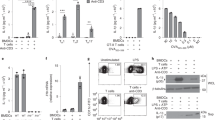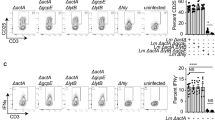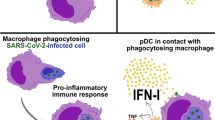Abstract
Innate sensing mechanisms trigger a variety of humoral and cellular events that are essential to adaptive immune responses. Here we describe an innate sensing pathway triggered by Plasmodium infection that regulates dendritic cell homeostasis and adaptive immunity through Flt3 ligand (Flt3l) release. Plasmodium-induced Flt3l release in mice requires Toll-like receptor (TLR) activation and type I interferon (IFN) production. We found that type I IFN supports the upregulation of xanthine dehydrogenase, which metabolizes the xanthine accumulating in infected erythrocytes to uric acid. Uric acid crystals trigger mast cells to release soluble Flt3l from a pre-synthesized membrane-associated precursor. During infection, Flt3l preferentially stimulates expansion of the CD8-α+ dendritic cell subset or its BDCA3+ human dendritic cell equivalent and has a substantial impact on the magnitude of T cell activation, mostly in the CD8+ compartment. Our findings highlight a new mechanism that regulates dendritic cell homeostasis and T cell responses to infection.
This is a preview of subscription content, access via your institution
Access options
Subscribe to this journal
Receive 12 print issues and online access
$209.00 per year
only $17.42 per issue
Buy this article
- Purchase on Springer Link
- Instant access to full article PDF
Prices may be subject to local taxes which are calculated during checkout






Similar content being viewed by others
References
McKenna, H.J. et al. Mice lacking flt3 ligand have deficient hematopoiesis affecting hematopoietic progenitor cells, dendritic cells, and natural killer cells. Blood 95, 3489–3497 (2000).
D'Amico, A. & Wu, L. The early progenitors of mouse dendritic cells and plasmacytoid predendritic cells are within the bone marrow hemopoietic precursors expressing Flt3. J. Exp. Med. 198, 293–303 (2003).
Karsunky, H., Merad, M., Cozzio, A., Weissman, I.L. & Manz, M.G. Flt3 ligand regulates dendritic cell development from Flt3+ lymphoid and myeloid-committed progenitors to Flt3+ dendritic cells in vivo. J. Exp. Med. 198, 305–313 (2003).
Waskow, C. et al. The receptor tyrosine kinase Flt3 is required for dendritic cell development in peripheral lymphoid tissues. Nat. Immunol. 9, 676–683 (2008).
Liu, K. & Nussenzweig, M.C. Origin and development of dendritic cells. Immunol. Rev. 234, 45–54 (2010).
Geissmann, F. et al. Development of monocytes, macrophages, and dendritic cells. Science 327, 656–661 (2010).
Christensen, J.L. & Weissman, I.L. Flk-2 is a marker in hematopoietic stem cell differentiation: a simple method to isolate long-term stem cells. Proc. Natl. Acad. Sci. USA 98, 14541–14546 (2001).
Adolfsson, J. et al. Upregulation of Flt3 expression within the bone marrow Lin−Sca1+c-kit+ stem cell compartment is accompanied by loss of self-renewal capacity. Immunity 15, 659–669 (2001).
Fogg, D.K. et al. A clonogenic bone marrow progenitor specific for macrophages and dendritic cells. Science 311, 83–87 (2006).
Onai, N. et al. Identification of clonogenic common Flt3+M-CSFR+ plasmacytoid and conventional dendritic cell progenitors in mouse bone marrow. Nat. Immunol. 8, 1207–1216 (2007).
Liu, K. et al. In vivo analysis of dendritic cell development and homeostasis. Science 324, 392–397 (2009).
Diao, J., Winter, E., Chen, W., Cantin, C. & Cattral, M.S. Characterization of distinct conventional and plasmacytoid dendritic cell–committed precursors in murine bone marrow. J. Immunol. 173, 1826–1833 (2004).
Naik, S.H. et al. Intrasplenic steady-state dendritic cell precursors that are distinct from monocytes. Nat. Immunol. 7, 663–671 (2006).
Leisewitz, A.L. et al. Response of the splenic dendritic cell population to malaria infection. Infect. Immun. 72, 4233–4239 (2004).
Sponaas, A.M. et al. Malaria infection changes the ability of splenic dendritic cell populations to stimulate antigen-specific T cells. J. Exp. Med. 203, 1427–1433 (2006).
Mackarehtschian, K. et al. Targeted disruption of the flk2/flt3 gene leads to deficiencies in primitive hematopoietic progenitors. Immunity 3, 147–161 (1995).
Belyaev, N.N. et al. Induction of an IL7-R+c-Kithi myelolymphoid progenitor critically dependent on IFN-γ signaling during acute malaria. Nat. Immunol. 11, 477–485 (2010).
Poulin, L.F. et al. Characterization of human DNGR-1+ BDCA3+ leukocytes as putative equivalents of mouse CD8α+ dendritic cells. J. Exp. Med. 207, 1261–1271 (2010).
Farrand, K.J. et al. Langerin+ CD8α+ dendritic cells are critical for cross-priming and IL-12 production in response to systemic antigens. J. Immunol. 183, 7732–7742 (2009).
Suss, G., Eichmann, K., Kury, E., Linke, A. & Langhorne, J. Roles of CD4- and CD8-bearing T lymphocytes in the immune response to the erythrocytic stages of Plasmodium chabaudi. Infect. Immun. 56, 3081–3088 (1988).
Belnoue, E. et al. On the pathogenic role of brain-sequestered αβ CD8+ T cells in experimental cerebral malaria. J. Immunol. 169, 6369–6375 (2002).
Lundie, R.J. et al. Blood-stage Plasmodium infection induces CD8+ T lymphocytes to parasite-expressed antigens, largely regulated by CD8α+ dendritic cells. Proc. Natl. Acad. Sci. USA 105, 14509–14514 (2008).
Claser, C. et al. CD8+ T cells and IFN-γ mediate the time-dependent accumulation of infected red blood cells in deep organs during experimental cerebral malaria. PLoS ONE 6, e18720 (2011).
Soule, B.P. et al. Effects of gamma radiation on FcɛRI and TLR-mediated mast cell activation. J. Immunol. 179, 3276–3286 (2007).
Berrozpe, G. et al. The W(sh), W(57), and Ph Kit expression mutations define tissue-specific control elements located between −23 and −154 kb upstream of Kit. Blood 94, 2658–2666 (1999).
Orengo, J.M. et al. Uric acid is a mediator of the Plasmodium falciparum–induced inflammatory response. PLoS ONE 4, e5194 (2009).
Orengo, J.M. et al. Plasmodium-induced inflammation by uric acid. PLoS Pathog. 4, e1000013 (2008).
Ng, G. et al. Receptor-independent, direct membrane binding leads to cell-surface lipid sorting and Syk kinase activation in dendritic cells. Immunity 29, 807–818 (2008).
Kool, M. et al. An unexpected role for uric acid as an inducer of T helper 2 cell immunity to inhaled antigens and inflammatory mediator of allergic asthma. Immunity 34, 527–540 (2011).
van de Hoef, D.L. et al. Plasmodium falciparum-derived uric acid precipitates induce maturation of dendritic cells. PLoS ONE 8, e55584 (2013).
Stocker, R., Hunt, N.H. & Weidemann, M.J. Antioxidants in plasma from mice infected with Plasmodium vinckei. Biochem. Biophys. Res. Commun. 134, 152–158 (1986).
Sanni, L.A. et al. Are reactive oxygen species involved in the pathogenesis of murine cerebral malaria? J. Infect. Dis. 179, 217–222 (1999).
Das, B.S. et al. Plasma antioxidants and lipid peroxidation products in falciparum malaria. Am. J. Trop. Med. Hyg. 49, 720–725 (1993).
Lopera-Mesa, T.M. et al. Plasma uric acid levels correlate with inflammation and disease severity in Malian children with Plasmodium falciparum malaria. PLoS ONE 7, e46424 (2012).
Pichyangkul, S. et al. Malaria blood stage parasites activate human plasmacytoid dendritic cells and murine dendritic cells through a Toll-like receptor 9–dependent pathway. J. Immunol. 172, 4926–4933 (2004).
Franklin, B.S. et al. MyD88-dependent activation of dendritic cells and CD4+ T lymphocytes mediates symptoms, but is not required for the immunological control of parasites during rodent malaria. Microbes Infect. 9, 881–890 (2007).
Coban, C., Ishii, K.J., Horii, T. & Akira, S. Manipulation of host innate immune responses by the malaria parasite. Trends Microbiol. 15, 271–278 (2007).
Voisine, C., Mastelic, B., Sponaas, A.M. & Langhorne, J. Classical CD11c+ dendritic cells, not plasmacytoid dendritic cells, induce T cell responses to Plasmodium chabaudi malaria. Int. J. Parasitol. 40, 711–719 (2010).
Urban, B.C. et al. Frequencies of peripheral blood myeloid cells in healthy Kenyan children with α+ thalassemia and the sickle cell trait. Am. J. Trop. Med. Hyg. 74, 578–584 (2006).
Bachem, A. et al. Superior antigen cross-presentation and XCR1 expression define human CD11c+CD141+ cells as homologues of mouse CD8+ dendritic cells. J. Exp. Med. 207, 1273–1281 (2010).
Crozat, K. et al. The XC chemokine receptor 1 is a conserved selective marker of mammalian cells homologous to mouse CD8α+ dendritic cells. J. Exp. Med. 207, 1283–1292 (2010).
Jongbloed, S.L. et al. Human CD141+ (BDCA-3)+ dendritic cells (DCs) represent a unique myeloid DC subset that cross-presents necrotic cell antigens. J. Exp. Med. 207, 1247–1260 (2010).
Ginhoux, F. et al. The origin and development of nonlymphoid tissue CD103+ DCs. J. Exp. Med. 206, 3115–3130 (2009).
Tamura, T., Kimura, K., Yuda, M. & Yui, K. Prevention of experimental cerebral malaria by Flt3 ligand during infection with Plasmodium berghei ANKA. Infect. Immun. 79, 3947–3956 (2011).
Darrasse-Jeze, G. et al. Feedback control of regulatory T cell homeostasis by dendritic cells in vivo. J. Exp. Med. 206, 1853–1862 (2009).
Eidenschenk, C. et al. Flt3 permits survival during infection by rendering dendritic cells competent to activate NK cells. Proc. Natl. Acad. Sci. USA 107, 9759–9764 (2010).
Suto, H. et al. Mast cell–associated TNF promotes dendritic cell migration. J. Immunol. 176, 4102–4112 (2006).
Shelburne, C.P. et al. Mast cells augment adaptive immunity by orchestrating dendritic cell trafficking through infected tissues. Cell Host Microbe 6, 331–342 (2009).
Dudeck, A. et al. Mast cells are key promoters of contact allergy that mediate the adjuvant effects of haptens. Immunity 34, 973–984 (2011).
de Vries, V.C. et al. Mast cell degranulation breaks peripheral tolerance. Am. J. Transplant. 9, 2270–2280 (2009).
Coban, C. et al. Pathological role of Toll-like receptor signaling in cerebral malaria. Int. Immunol. 19, 67–79 (2007).
Haque, A. et al. Type I interferons suppress CD4+ T-cell–dependent parasite control during blood-stage Plasmodium infection. Eur. J. Immunol. 41, 2688–2698 (2011).
Shi, Y., Evans, J.E. & Rock, K.L. Molecular identification of a danger signal that alerts the immune system to dying cells. Nature 425, 516–521 (2003).
Lundie, R.J. et al. Blood-stage Plasmodium berghei infection leads to short-lived parasite-associated antigen presentation by dendritic cells. Eur. J. Immunol. 40, 1674–1681 (2010).
Wykes, M.N. et al. Plasmodium strain determines dendritic cell function essential for survival from malaria. PLoS Pathog. 3, e96 (2007).
Jung, S. et al. In vivo depletion of CD11c+ dendritic cells abrogates priming of CD8+ T cells by exogenous cell-associated antigens. Immunity 17, 211–220 (2002).
deWalick, S. et al. Cutting edge: conventional dendritic cells are the critical APC required for the induction of experimental cerebral malaria. J. Immunol. 178, 6033–6037 (2007).
GeurtsvanKessel, C.H. et al. Clearance of influenza virus from the lung depends on migratory langerin+CD11b− but not plasmacytoid dendritic cells. J. Exp. Med. 205, 1621–1634 (2008).
Hildner, K. et al. Batf3 deficiency reveals a critical role for CD8α+ dendritic cells in cytotoxic T cell immunity. Science 322, 1097–1100 (2008).
Poulin, L.F. et al. The dermis contains langerin+ dendritic cells that develop and function independently of epidermal Langerhans cells. J. Exp. Med. 204, 3119–3131 (2007).
Acknowledgements
We thank R. Steinman, M.P. Longhi, E. Pamer, I. Leiner and K. Marsh for helpful discussion and reagents or critical reading of the manuscript and Celldex for human recombinant FLT3L. We thank I. Lemischka (Mount Sinai School of Medicine) the for the Flt3−/− mice and B. Malissen (Centre d'Immunologie de Marseille-Luminy) for the langerin-DTR mice. We thank the children and their guardians for participation. This paper is published with the permission of the Director of the KEMRI. This work was supported in part by US National Institutes of Health grant number AI051573 and the Agency for Science, Technology and Research (Singapore). P.G. is a Centre National de la Recherche Scientifique (CNRS) investigator. B.C.U. is a Wellcome Trust Senior Research Fellow (grant 079082). M.C.N. is a Howard Hughes Medical Institute (HHMI) investigator.
Author information
Authors and Affiliations
Contributions
M.C.N., P.G., B.C.U., M. Merad, Y.S., F.G., L.R., J.H., C.C. and S.D. participated in the experimental design. G.B., H.A.S., N.F.-S., E.B., M.D., C.M.R., A.P. and F.K. were involved in the production and analysis of NSG humanized mice. M.S. and M.C. provided BDCA2-DTR mice. P.G., J.H., C.C., S.D., H.K., A.G., G.D.-J., S.B.T., A.O.K., M. Meredith, R.N., C.T., F.M., A.H., D.B. and T.E. conducted most of the immunological experiments in mice.
Corresponding author
Ethics declarations
Competing interests
The authors declare no competing financial interests.
Supplementary information
Supplementary Text and Figures
Supplementary Figures 1–15 and Supplementary Methods (PDF 3189 kb)
Rights and permissions
About this article
Cite this article
Guermonprez, P., Helft, J., Claser, C. et al. Inflammatory Flt3l is essential to mobilize dendritic cells and for T cell responses during Plasmodium infection. Nat Med 19, 730–738 (2013). https://doi.org/10.1038/nm.3197
Received:
Accepted:
Published:
Issue Date:
DOI: https://doi.org/10.1038/nm.3197
This article is cited by
-
Xanthine oxidase levels and immune dysregulation are independently associated with anemia in Plasmodium falciparum malaria
Scientific Reports (2023)
-
The role of non-coding RNA in lupus nephritis
Human Cell (2023)
-
CD40 stimulation as a molecular adjuvant for cancer vaccines and other immunotherapies
Cellular & Molecular Immunology (2022)
-
Dendritic cells in cancer immunology
Cellular & Molecular Immunology (2022)
-
A 92 protein inflammation panel performed on sonicate fluid differentiates periprosthetic joint infection from non-infectious causes of arthroplasty failure
Scientific Reports (2022)



